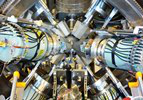Prof.
Klaus Blaum
(Max Planck Institut für Kernphysik)
21/10/2016, 09:05
Invited
Collinear laser spectroscopy provides access to nuclear ground-state properties via the hyperfine structure (including the isotope shift) of atomic spectra. This is still the only technique to access information on nuclear charge radii along long isotopic chains from neutron-deficient up to very neutron-rich isotopes and lifetimes down to the millisecond scale. Also nuclear moments can be...
Dr
Magdalena Kowalska
(CERN PH Department)
21/10/2016, 09:35
Invited
-ray transitions in muonic atoms have been used to derive absolute charge radii of many stable nuclei. Presently, the obtained radii, together with those provided by electron scattering, are used extensively as input to connect the optical isotope shifts with changes in charge radii for radioactive nuclei. Laser spectroscopy on radioactive nuclei which provides these optical isotope shifts is...
Prof.
Ingo Sick
(University of Basel, Department of Physics)
21/10/2016, 10:05
Invited
We discuss the information on nuclear densities that can be determined via elastic electron scattering. This is compared to the knowledge that results from the analysis of muonic X-ray data. The complementary nature of the two probes is emphasized. We also address the question how how more detailed properties of nuclear densities could in the future be investigated with muonic X-rays.
Prof.
Paul Indelicato
(Laboratoire Kastler Brossel, CNRS)
21/10/2016, 11:00
Invited
In this talk I will describe QED calculations of transition energies in muonic atoms. I will particularly focus on the nuclear model dependence of the Coulomb and QED corrections. IN particular, energies evaluated using Fourrier-Bessel or Sum of Gaussian and Fermi models with identical mean-spherical radius will be compared. Effect on the hyperfine structure will be also be examined.
Dr
Patrick Strasser
(KEK)
21/10/2016, 11:30
Invited
Muonic atom spectroscopy is a unique tool to determine the nuclear charge distribution and has successfully been used for many years to measure sable isotopes. Several years ago the cold hydrogen film method was proposed to expand muonic atom spectroscopy by utilizing nuclear beams, including, in the future, radioactive isotope beams. Muonic radioactive atoms would be produced by utilizing the...
Andreas Knecht
(Paul Scherrer Institut)
21/10/2016, 12:00
Invited
Muonic atoms as laboratories for fundamental physics provide crucial input to
quantum electrodynamics, the weak interaction and the strong interaction. Many
studies of muonic atoms have relied on the detection of X-ray from the muonic
cascades. Most stable and a few unstable isotopes have been investigated with
muonic atom spectroscopy techniques. In particular, muonic atoms have been used...

